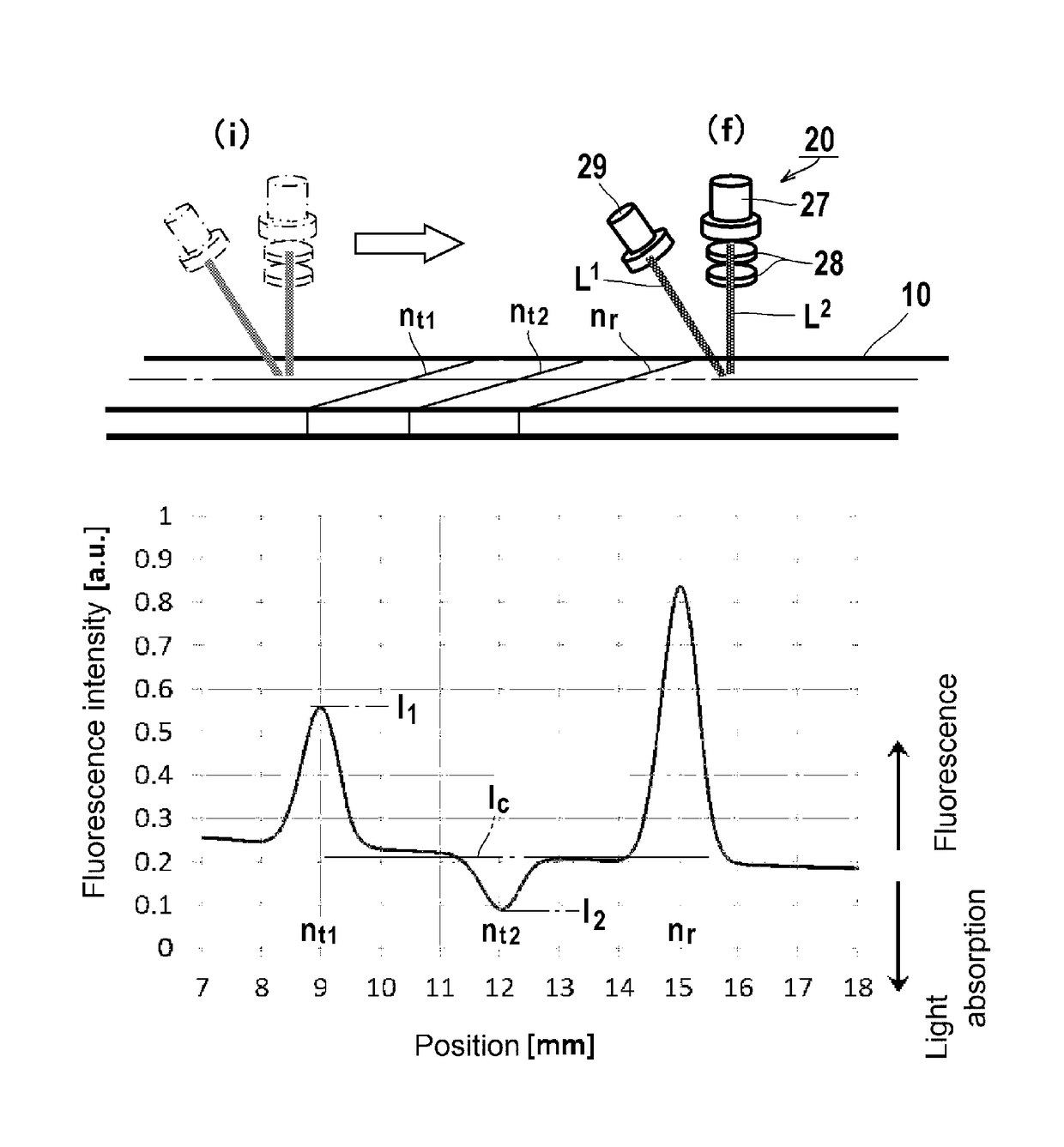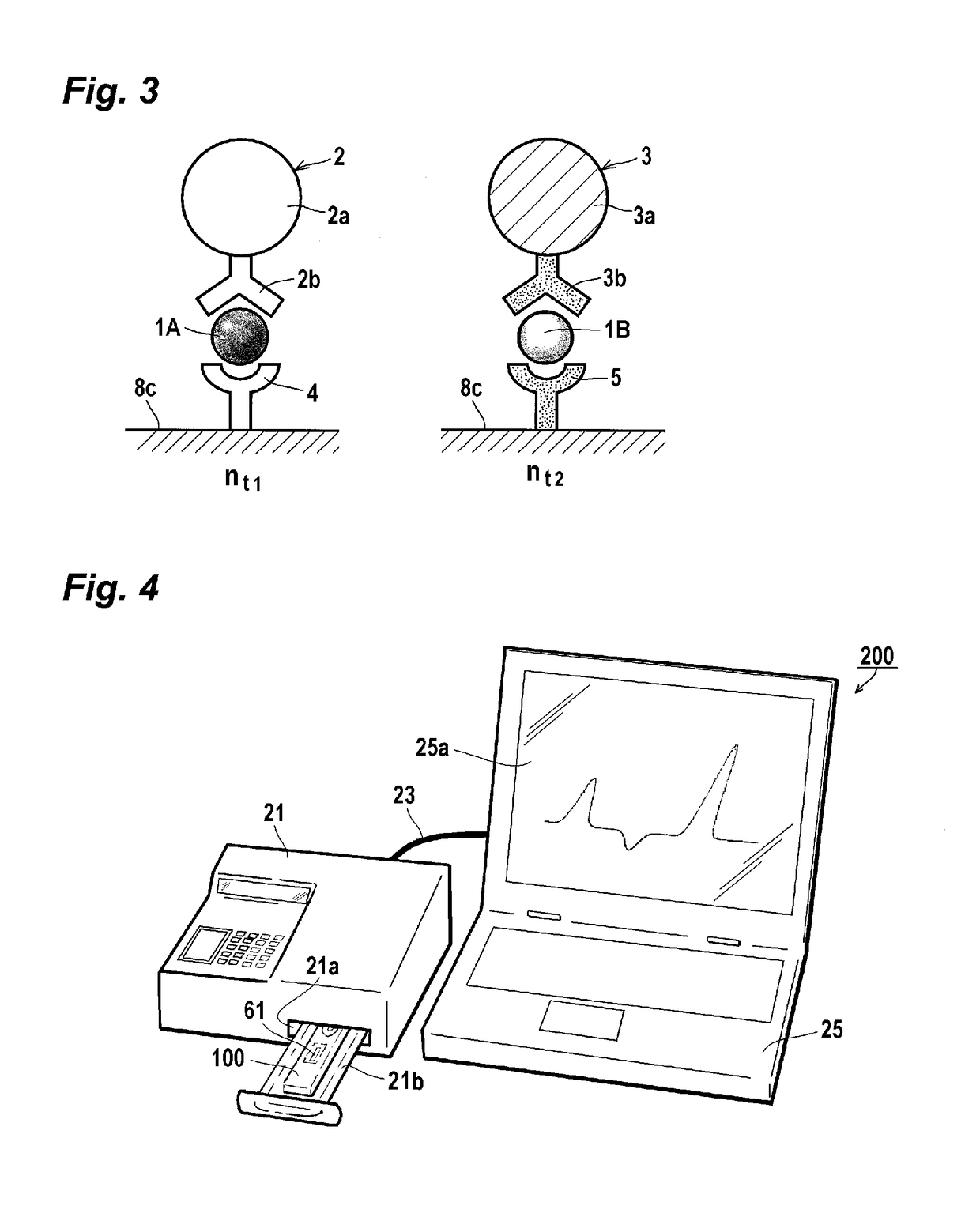Immunochromatography, and detection device and reagent for the same
a detection device and reagent technology, applied in the field of immunochromatography, can solve the problems of insufficient sensitivity of immunochromatography using such colored particles, and achieve the effects of reducing device cost, space saving, and improving the efficiency of immunochromatographic tests
- Summary
- Abstract
- Description
- Claims
- Application Information
AI Technical Summary
Benefits of technology
Problems solved by technology
Method used
Image
Examples
preparation example 1 (
Preparation of Fluorescent Silica Nanoparticles)
[0149]2.9 mg of 5-(and-6)-carboxyrhodamine 6G.succinimidyl ester (trade name, manufactured by EMP Biotech GmbH) was dissolved in 1 mL of dimethyl formamide (DMF). Then, 1.3 μL of APS was added thereto and the reaction was carried out for 1 hour at room temperature (25° C.).
[0150]600 μL of the resulting reaction liquid was admixed with 140 mL of ethanol, 6.5 mL of TEOS, 35 mL of distilled water, and 15.5 mL of 28% by mass ammonia water, and the reaction was allowed to occur at room temperature for 24 hours.
[0151]The reaction solution was centrifuged at a gravitational acceleration of 15,000×g for 30 minutes, and the supernatant was removed. 4 mL of distilled water was added to the precipitated silica particles for dispersion, and the dispersion was centrifuged again at a gravitational acceleration of 15,000×g for 20 minutes. Further, this washing operation was repeated twice additionally, for removal of the unreacted TEOS, ammonia and o...
preparation example 2 (
Preparation of Complex Particles of Fluorescent Silica Particles and an Antibody)
[0152]To 100 μL of dispersion solution (dispersion medium: distilled water) of the fluorescent silica particles (average particle diameter; 197 nm) containing rhodamine 6G at a concentration of 5 mg / mL, which had been used in Preparation Example 1, 775 μL of distilled water, 100 μL of an aqueous solution of sodium alginate with a concentration of 10 mg / mL (weight average molecular weight: 70,000), and 25 μL of an aqueous ammonia solution with a concentration of 28% by weight were added. Then, the mixture was slowly stirred for 1 hour at room temperature (24° C.). The obtained colloid was subjected to centrifugation for 30 minutes with a gravitational acceleration of 12,000×g, and then the supernatant was removed. Distilled water (875 μL) was added thereto and the particles were re-dispersed. Subsequently, 100 μL of an aqueous solution of sodium alginate with a concentration of 10 mg / mL was added thereto...
preparation example 3 (
Preparation of Complex Particles of Gold Colloid Particles and an Antibody)
[0156]To 0.5 mL of gold colloid (particle diameter: 40 nm), 100 μL of 50 μg / mL antibody to nucleoprotein of influenza B (Anti-Human Influenza B, Monoclonal (Clone 9D6), manufactured by Takara Bio Inc.) was added, and then the mixture was allowed to stand at room temperature for 10 minutes. Subsequently, 100 μL of a phosphate buffer (pH 7.5) containing 1% by weight of bovine serum albumin was added, and the mixture was further allowed to stand at room temperature for 10 minutes. The mixture was then centrifuged at 8,000×G for 15 minutes, and the supernatant was removed. Then, 100 μL of a phosphate buffer (pH 7.5) containing 1% by weight of bovine serum albumin was added to disperse the particles.
PUM
| Property | Measurement | Unit |
|---|---|---|
| wavelength | aaaaa | aaaaa |
| distance | aaaaa | aaaaa |
| absorption wavelength | aaaaa | aaaaa |
Abstract
Description
Claims
Application Information
 Login to View More
Login to View More - R&D
- Intellectual Property
- Life Sciences
- Materials
- Tech Scout
- Unparalleled Data Quality
- Higher Quality Content
- 60% Fewer Hallucinations
Browse by: Latest US Patents, China's latest patents, Technical Efficacy Thesaurus, Application Domain, Technology Topic, Popular Technical Reports.
© 2025 PatSnap. All rights reserved.Legal|Privacy policy|Modern Slavery Act Transparency Statement|Sitemap|About US| Contact US: help@patsnap.com



